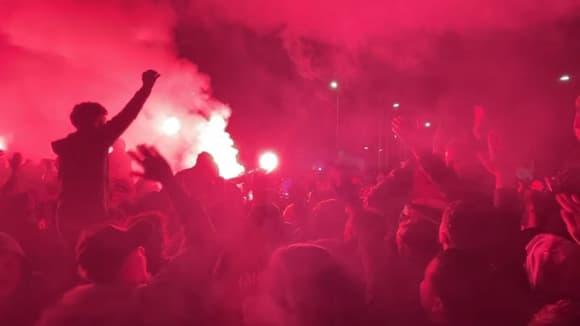The Vieux-Pays district in Tremblay-en-France has never lived up to its name so well.
Not far from the runways of Roissy airport, north of the Ru du Sausset, the teams of the private research office Éveha recently made a rare discovery, one that their authors remember all their lives.
This excavation site, whose perimeter of five hectares was delimited by the regional directorate of cultural affairs, brought to light a necropolis of more than 1,200 burials dating from the High Middle Ages.
Completed last December, this work precedes the installation of a rainwater retention basin in the Aerolians business area.
The archaeologists of Eveha were commissioned by Grand Paris Aménagement, which is carrying out an ecological and landscaping project in this area alongside the territory of Paris Terres d'Envol and the metropolis of Grand Paris.
Such a find makes Tremblay "one of the highest burial sites in France," says Cyrille Le Forestier, archaeo-anthropologist at the National Institute for Preventive Archaeological Research (Inrap), which has several excavations of this type in Seine- Saint-Denis to his credit.
A village from the 6th-12th centuries was unearthed during excavations in 2014-2015
“In fifteen years, I have had the chance to participate in very beautiful projects, and that of the retention basin will undoubtedly remain one of the most important, confirms Aurélie Mayer, the operation manager at Tremblay.
It is a rarity in Ile-de-France and even in France to unearth a necropolis of this magnitude and to be able to excavate it in its entirety.
"
To the south of the ru, a "large-scale" village had already been the subject of studies in 2014 and 2015 by the company Archeodunum.
"We already had very good information on the site since the necropolis is linked to this village, which we know dates from the 6th-12th centuries," explains Aurélie Mayer.
We therefore know that the necropolis is dated from this period.
"
The oldest tombs, those from the Merovingian period - from the 6th to the 8th century - are the richest in objects and furniture, and therefore the easiest to date.
"Fibulas, pearls, belt buckles, weapons ...: we know quite well how they evolve over time", explains the person in charge of the excavations.
The graves and their skeletons will be studied for three years
For the following eras, with more bare burials, the shape of the graves or the way in which the deceased were buried offer precious clues to Eveha's teams.
Carbon-14 analyzes will make it possible to refine the dating.
The 1,200 graves and their skeletons will be studied over three years.
"We are a little over our hunger as for the state of conservation of the bones, very variable," confides Aurélie Mayer.
Like all the necropolises of the Merovingian periods, a lot of archaeological furniture accompanies the deceased.
But these graves have often been looted.
"
More than their condition, it is their number that surprised archaeologists.
During the pre-excavation assessment, which consists of surveying about 10% of the land in question, only about forty had been identified.
"The total number of graves was then estimated at 300," said the site manager.
Successive discoveries have led to the expansion of the research area.
To the delight of Aurélie Mayer and her colleagues.
Archaeologists will agree that the necropolis of 1,200 burials unearthed in Tremblay-en-France is not rare.
It is his discovery that is.
The scale of the site would even be modest in relation to the period it covers, according to Cyrille Le Forestier.
"The occupation of the village spanning five or six centuries, there could be ten times as many graves," estimates this archaeo-anthropologist from Inrap.
If the necropolis is complete, that would mean that only one or two people were buried there each year.
"
Newsletter The essential of 93
A tour of the news in Seine-Saint-Denis and the IDF
Subscribe to the newsletterAll newsletters
In Tremblay, the site was carried out on a five-hectare right-of-way, when most of these operations often only involve a few thousand square meters.
“You don't search the necropolises all at once,” explains Cyrille Le Forestier.
Preventive excavations and their scope of intervention in fact obey real estate projects and land use planning.
One of the first departmental archeology services
This is why Seine-Saint-Denis, whose history is inseparable from the construction of the Saint-Denis basilica at the end of Antiquity, today constitutes one of the privileged playgrounds for archaeologists.
“The pace of construction is much more important there than in Yvelines or Hauts-de-Seine, observes Cyrille Le Forestier.
Seine-Saint-Denis is also one of the first in France to have an archaeological service [
Editor's note: in 1991
].
There is a political will to show the department in a different light.
"
From 1992, the largest Gallic necropolis in Europe was brought to light in Avicenna, during an intervention prior to the construction of a new building within the Balbynien hospital.
Fifteen years later, graves of victims of the Black Death of 1348 were discovered in Bondy, a find "unique in France".
More recently, Inrap has stepped up excavations at the Mastraits site in Noisy-le-Grand.
“We have been excavating this necropolis for ten years.
We are at 800 graves, slips Cyril Le Forestier.
An excavation program has been established for three years.
We start again in June.
We are going to bring out a hundred more graves.
"









